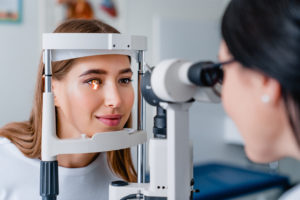
Humans are visual animals, collecting 80 to 85% of the information the brain uses visually. You use your eyes for everything you do during the day. If you lose your vision, you may have to relearn many of the daily activities you take for granted.
Even an injury that does not render you blind can affect your life, and a serious eye injury will require medical treatment. Depending on how much your injury affects your vision, you may need assistive technologies and occupational therapy.
You can learn about eye injuries and how to recover compensation for such an injury below.
What Is the Structure and Function of Your Eyes?

Your sense organs collect information. Your brain uses this information to decide how to control your body. It controls your mouth to spit out things that taste foul to protect you against diseases and poisons. It causes your body to sweat when your skin senses heat. And it moves your arm to steer your car to avoid a car accident when you see an oncoming vehicle.
Your eyes have a cornea at their front to protect the lens and pupil. The pupil is the opening behind the cornea that allows light into the eyeball, also called the globe. The iris controls the size of the pupil to allow the right amount of light to come in. Behind the cornea, the lens focuses light passing through the pupil to create a sharp image on the retina.
The retina has several kinds of light-sensitive cells that detect the amount and color of light. The light and color information gets passed along the optic nerve to the brain, which decodes the information gathered by the eye to create an image.
The globe sits in a socket in the skull called the orbit. The orbit includes the bones surrounding the front of the eye to keep it in the skull. It also includes the thin bones above, behind, and below the globe that support it and provide anchor points for the muscles that move the eye.
Your eye connects to your skull through muscles. Blood vessels deliver oxygenated blood to your eye and carry away oxygen-depleted blood. Nerves carry signals that control the muscles that move your eye and eyelids, and you also have nerve endings in your eye to sense pressure and pain.
What Causes Eye Injuries?
Eye trauma can take a few different forms, including:
Penetrating Injuries
Penetrating injuries happen when an object creates an open wound in your eye. This type of wound can affect not only your globe but your eyelid, eye muscles, or other structures.
Penetrating injuries usually happen when something gets propelled into your eye or when you get thrown into an object. A flying piece of metal during a motorcycle accident could hit your eye and cause a penetrating injury.
Penetrating injuries are serious because they can cause bleeding and infection in addition to damaging eye tissue.
Blunt Force Injuries
Blunt force injuries happen when something impacts your eye without leaving an open wound and can occur anytime something hits your face. When you impact the ground after a slip and fall accident, you could suffer a blunt force injury to your eye.
Burns
Burns occur when a chemical reaction destroys tissue. Your eye can suffer a thermal burn when a hot object touches it or a combustion burn if your flesh catches on fire. A chemical burn occurs when a caustic substance gets splashed into your eye.
Foreign Objects
A foreign object injury involves any object that enters your eye. Foreign objects do not necessarily cause a penetrating injury. They could scratch the eye’s surface or get trapped between the globe and the orbital.
What Are Some Examples of Eye Injuries?
Eye injuries can take many forms depending on the structures that get damaged. Some examples of eye injuries include:
Scratched Cornea
A scratched cornea is a very common eye injury. It happens when debris abrades the cornea at the front of the eye.
Symptoms of a corneal abrasion include:
- Pain
- Watery eye
- Redness
- Sensitivity to light
- Blurry vision
A corneal abrasion usually heals on its own in a few days. Your doctor may prescribe antibiotic eye drops to reduce the risk of infection.
Ruptured Globe
A ruptured globe happens when your eye bursts when it gets crushed or hit. A ruptured globe will almost always result in some loss of vision.
Doctors treat a ruptured globe by closing the tears with sutures and monitoring you for complications like a detached retina.
Fractured Orbital
You may suffer a fractured orbital when you get hit by a blunt force. When the bones around the eye get fractured, bone fragments can pierce the eye. Fragments can also damage the structures around the eye, such as the muscles, blood vessels, or optic nerve.
If the orbital floor gets damaged, the eye may move out of position, leading to misaligned eyes. When your eyes do not line up, you may have blurry or double vision.
Detached Retina
The retina is responsible for your vision. If the retina detaches from the back of your eye, you will lose sight. Without emergency surgery to repair it, the retina will die from lack of blood flow, and you will have permanent vision loss.
How Do You Get Compensation for an Eye Injury?
You may seek compensation if your accident resulted from someone else’s negligence. To prove negligence, you need to show that someone else failed to act with reasonable care. This could mean that they took an unreasonably dangerous action. Or it could mean that they failed to do something when a reasonable person would have acted.
If you prove negligence, your damages can include economic and non-economic losses. Economic damages include the financial costs of your injury, such as the costs of medical treatment. They also include the wages you lost during your recovery. If you need to change your job or the hours you worked due to vision loss, you can also seek compensation for your diminished earning capacity.
Non-economic damages include the ways your eye injury reduces your quality of life. Examples of non-economic losses include pain, mental anguish, disability, and a reduction in your enjoyment of life. Contact or call Roman Austin Car Accident and Personal Injury Lawyers at (727) 787-2500 for a free consultation to discuss the compensation you can seek for your eye injury.

